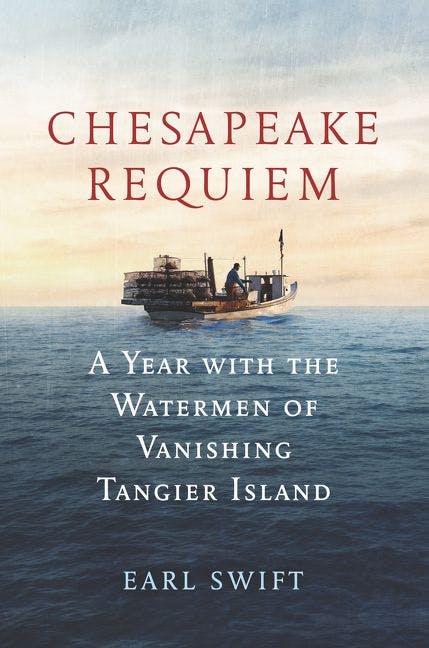Futuristic novels brim with images of coastal cities drowning in rising seas: New York City in Kim Stanley Robinson’s New York 2140, Melbourne in George Turner’s The Drowned Towers, London in Megan Hunter’s The End We Start From. But in some communities, that scenario feels increasingly less like science fiction and more like fate. That’s certainly true for Carol Pruitt Moore who lives on Tangier Island, Virginia—a tiny knob of land in the Chesapeake Bay about an hour’s ferry ride from the mainland. In October 2012, Hurricane Sandy pummeled the island, causing the already rising seas to spill over the streets and into the homes of Tangier’s 481 residents. A few days after the storm, Carol steered her skiff toward the island’s uppermost tip to survey the damage. Along the shoreline, soil was sluicing into the bay each time the waves hit. A human skull floated at the water’s edge—the remains of a body broken free from an eroded grave.

That poignant anecdote opens Earl Swift’s book Chesapeake Requiem: a Year with the Watermen of Vanishing Tangier Island. The island is one of only a few left in the Chesapeake Bay. Its less fortunate siblings—like the once five-mile long Holland Island—have already succumbed to sea-level rise caused by climate change. And the future looks bleak for the islands that remain. Scientists predict that Smith Island, home to approximately 280 Maryland residents, will be underwater by 2100. Tangier, which is only four feet above sea level at its peak and loses an average of 15 feet of coast every year, may be gone sooner. Communities all over the world are affected: The Senegalese port of Joal—the subject of Anna Badkhen’s recent book Fisherman’s Blues: A West African Community at Sea—is at risk of losing its traditional ways of life. Primarily a fishing community, the fishermen’s daily catch is only a tenth of what it was just ten years before.
It wouldn’t be impossible to save these communities. But it’s improbable anyone will step in. In Tangier’s case, Swift suggests that government intervention to save the place is unlikely. Before any construction on a flood-management project could begin, Congress would have to approve a three-year study on it. Such a study would cost approximately $800 million to complete—the equivalent “of giving everyone on Tangier $2 million.” If the government awarded every family just $200,000, he continues, each could get “a really nice house somewhere else.” With the math against them, the residents of Tangier are facing the demise of their community as they know it. Requiem is therefore record of their disappearance as it happens.
At the heart of the book is a difficult question: Is Tangier worth saving? The answer depends, writes Swift, on what we as a society decide to value. We “will not have the money, the physical means, or the time to save” every place, he writes. “So we…will have to develop a rubric” for choosing which communities to protect from the encroaching sea. But how much is Tangier’s history worth? As much as New Orleans’s? As Miami’s? What if we decide that a population’s average household income is a worthier metric?
Swift, who first wrote about the island in 1999, spent a year there to write the book, getting to know the island’s people and the minutiae of their lives. Almost every man on Tangier, we learn, makes his living catching blue crab, but it’s the women who are “really in charge.” One of the book’s funnier moments comes when Swift, talking with Tangier’s mayor, James “Ooker” Eskridge, asks who is the boss. “Well,” the mayor says, “women have their input.” He throws a quick and nervous glance over his shoulder to see if his wife heard him. She pays him no attention at all.
Tangier is a deeply conservative community, and even though the island’s erosion problem and extreme weather are exacerbated by climate change, 87 percent of the islanders voted in the 2016 election for Donald Trump, who claims that climate change is a hoax. They told Swift it’s because Trump was the Christian candidate. Swift’s counterpoint that Trump is probably an atheist—and that Hillary Clinton is a life-long Methodist—seemed not to matter. Methodism is, in fact, the only religion officially practiced on Tangier: Alcohol can’t be purchased legally on the island, and swearing in public just isn’t done. The town council made news in 1998 for refusing Warner Bros. permission to film Message in a Bottle on the island, because the characters engaged in activity that “violated Christian mores.”
The island made news again in June 2017 when CNN arrived to investigate the receding shoreline. “I love Trump as any family member,” Eskridge told the camera. “We’d like to have a wall all the way around Tangier” to protect it from erosion. The president called Eskridge a few days later. According to an article in the Washington Post, Trump told Eskridge not to worry about rising sea levels because Tangier “has been there for hundreds of years, and … will be there for hundreds more.” When asked what he made of that, the mayor said he felt comforted.
Politicians like to talk about the closeness of small American towns, but the residents of Tangier are more than close—they would die for each other. In April 2017, a violent storm drowned the boat of one of Tangier’s most capable captains, Ed Charnock, and his son, Jason. Just before the boat went down, Jason radioed the island for help. Every able-bodied Tangierman who heard it took to the sea to save them, despite the water’s life-threatening conditions. They found Jason, but Ed was lost at sea. Almost everyone on the island would attend his funeral.
When Tangier disappears, these bonds will be broken, as residents move away and leave behind their way of life. Tangier is only one community, but it’s a sign of things to come. How many unique traditions, rituals, belief systems, and ways of working and speaking and praying are we willing to lose?
Like Chesapeake Requiem, Fisherman’s Blues offers a profound account of a single community—its primary industries, religious beliefs, and rhythms. For the people of Joal, the future looks bleak, but the present, as Badkhen describes it, is often quite beautiful. A fisherman’s boat, she writes, “rotates under the Milky Way as if on a turntable; so perfectly flat and depthless the sparkling sea, so perfectly flat and depthless the sparkling sky.” All that beauty, however, shares space with pollution and poverty. Trash and rotting sludge ring the shoreline, and men and women have to wade through it to greet the fishermen upon their return. One of the most successful fishing captains in Joal still had to build his seaside gazebo, his mbaar, from tree trunks and tin. The gazebo’s only bench for sitting was built from the wood of a shipwrecked boat and stacks of broken concrete blocks.

Like the men of Tangier, the men of Joal are defined largely by their work; a successful man is one who can feed and provide for his family. But while the aging population of Tangier laments the younger generation’s lack of interest in crabbing, Joal fishermen rely heavily on the labor of young boys, or oupas. Their job is to jump overboard and splash about to scare fish into nets. They’re paid the same as the captain and the first mate, an equal share of the pirogue’s catch. On a good day, a single crew can net up to 200 tons of fish. But that’s nothing compared to what fishermen were catching even a decade ago. “The sea is broken,” the fishermen told Badkhen. “The sea is empty.”
Global warming has raised the ocean’s temperature, increasing the water’s salinity and producing extreme and unpredictable weather patterns. All this has scared the fish away. What’s more, the fishermen have decimated the stocks. According to Badkhen, approximately twenty thousand pirogues are fishing along a mere thirty miles of Senegalese coastline. Meanwhile, foreign mechanized trawlers rake the ocean clean. The problems these interlopers present are not lost on the fishermen. One of them asks Badkhen if America has oceans like Senegal’s. She says the nation has three. “Then I don’t get it,” he replies. “Why do they send foreign ships to fish in our ocean if they have three of their own?” Unlike the fishermen of Tangier, the people of Joal are living with decisions made far away, in which they have no say or vote.
From Souaré’s pirogue she could see the oil rigs that international companies have constructed sixty miles offshore to mine oil and natural gas. In recent years the financial world has watched to see how and whether Senegal, a relative new-comer to the oil industry, escapes the curses of corruption, inflation, and increasing inequality that continue to trouble other African countries, such as Nigeria and Angola. In Fisherman’s Blues, Badkhen questions how the drilling will affect the fishermen, specifically. Souaré responds to the question with optimism: “No problem!” he says. “We’ll fish around the rigs.” But according to an analysis of Senegal’s energy sector commissioned by the Netherlands Enterprise Agency in 2017, the “discharges” that arise from “the drilling of exploration wells” similar to those constructed near Senegal are “potentially toxic to marine waters.” Spills could cause “considerable ecological damage.” If the fish disappear, then it follows that the fishermen’s livelihoods will disappear as well.
As both of these books make clear, climate change is already happening, and affecting most severely the communities that are already struggling. Each of these accounts unfolds like a novel, featuring well-drawn and sympathetic characters, and show how thoroughly the implications of environmental disaster seep into everyday life. When Souaré is throws a party to celebrate the birth of his daughter, he should be full of joy: A Joal tradition, the party includes an expensive meal, musicians, a sacrificial sheep. But as the morning light “casts a rectangle of bright white on the white tiles of the ward floor,” Badkhen writes, he stares dejectedly. “Anna,” he says. “I really don’t know how I will manage.” If we can imagine scenes like this in a novel, we should be able to grasp their implications in reality.